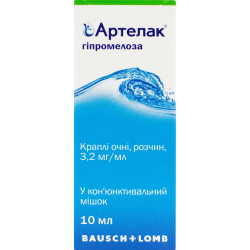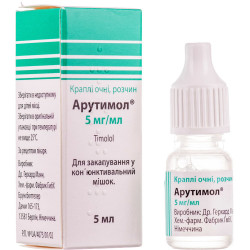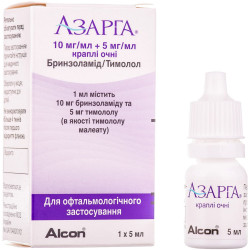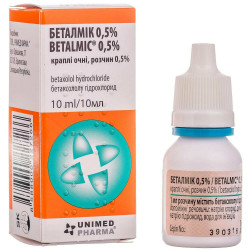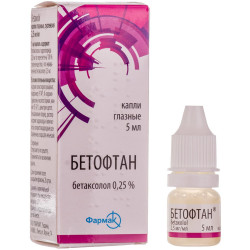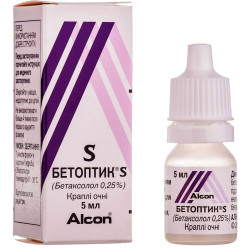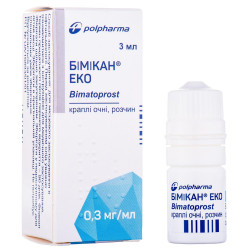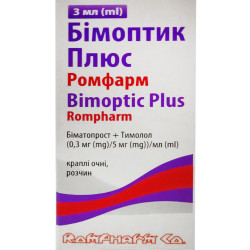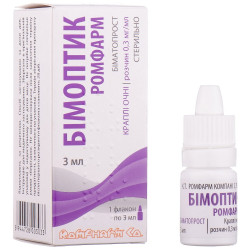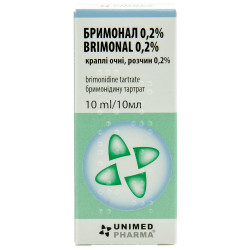









- Stock: In Stock
- Model: 179629
0% Customers recommend this product
-
5 Awesome0%
-
4 Great0%
-
3 Average0%
-
2 Bad0%
-
1 Poor0%
Reviews Over Azopt cap. eye. 1% fl. 5 ml
- (0)
Total Reviews (0)
click here write review to add review for this product.
Report this review.
Description
Pharmacological properties
Brinzolamid ((r) - (+)-4-etilamino-2-(3-metoksipropit)-3.4-дигидро-2н-тиено[3.2-e]-1.2-thiazin-6-sulfonamide-1.1-dioxide) — protivoglaukomny means, karboangidraza inhibitor. selectively the activity of a karboangidraza of ii oppresses (ii). a karboangidraz — the enzyme participating in process of hydration of carbon dioxide and dehydration of carbonic acid. in a human body this enzyme is provided by various isofermental forms, the most active of which is ii which is originally found in erythrocytes, and then and in cells of other fabrics including eye tissues. the inhibition of a ciliary body of an eye leads to decrease in secretion of intraocular liquid (mainly due to reduction of formation of ions of bicarbonate with the subsequent decrease in transport of sodium and liquid) and to lowering of intraocular pressure which increase is a major factor of pathogenesis of damage of an optic nerve and glaukomatozny visual field constriction.
indicators of activity and selectivity of inhibition concerning KA II makeFor a brinzolamid of in vitro: IK 50 = 3.2 nanometers, To and = 0.13 nanometers.
byAfter instillation in an eye brinzolamid it is soaked up in blood. Thanks to high affinity to KA of II brinzolamid quickly and easily gets into erythrocytes and has long elimination half-life from blood — about 111 days. In a human body the metabolite (N-dezetil-brinzolamid) which also accumulates in erythrocytes is formed and in the presence of a brinzolamid it is active mainly concerning KA of I. In blood plasma brinzolamid and its metabolite are defined in the minimum concentration which are in most cases lower than a limit of test-sensitivity of quantitative definition (less than 7.5 ng/ml). Contacts proteins of blood plasma approximately for 60%. Brinzolamid is brought mainly with urine in not changed look (about 60%). About 20% are removed in the form of a metabolite. In urine also small amounts of N-dezmetoksipropila and O-dezmetilirovannogo of a metabolite are found N-dezetil-brinzolamid.
When carrying out pharmacokinetic researches to healthy volunteers brinzolamid were appointed inside on 1 mg in capsules by 2 times a day for 32 weeks. For assessment of level of system oppression of KA the activity of KA was measured in erythrocytes. Saturation brinzolamidy KA-II of erythrocytes was reached in 4 weeks (concentration in erythrocytes made about 20 microns). N-dezetilbrinzolamid collected in erythrocytes before achievement of stable concentration which was in limits of 6-30 µmol for 20–28 weeks. Oppression of the general activity of KA-II of erythrocytes in an equilibrium state made about 70-75%.
to Patients with a moderate renal failure (clearance of creatinine of 30-60 ml/min.) were appointed inside on 1 mg of a brinzolamid by 2 times a day for 54 weeks. Concentration of a brinzolamid in erythrocytes in 4 weeks was in limits of 20-40 microns. In an equilibrium state concentration of a brinzolamid and its metabolite in erythrocytes were in limits of 22-46.1 and 17.1-88.6 microns respectively. At decrease in clearance of creatinine the concentration of N-dezetilbrinzolamida in erythrocytes increased, and the general activity of KA in erythrocytes decreased, however concentration of a brinzolamid in erythrocytes and activity of KA-II remained invariable. Patients with a profound renal failure had an extent of oppression of the general activity of KA above though it made less than 90% in an equilibrium state.
At a research with local introduction to eyes the concentration of a brinzolamid in erythrocytes in an equilibrium state was the same, as well as the concentration established at oral administration, however concentration of N-dezetilbrinzolamida was below. The activity of KA was about 40-70% of its initial level.
Indication
Increased intraocular pressure or an open angle glaucoma (as monotherapy at the patients insensitive to therapy by blockers of β-adrenoceptors, or at patients to whom blockers of β-adrenoceptors are contraindicated, or as an additional tool at therapy by blockers of β-adrenoceptors).
Use
At application of the azopt as monotherapy or additional therapy are dug in on 1 drop of medicine in a sore eye (eyes) by 2 times a day. at some patients the best result is achieved when assigning on 1 drop 3 times a day.
recommends to pressAfter burying the mouth of the lacrimonasal channel or to densely close eyelids for decrease in system absorption of medicine and decrease in a likelihood of development of system side effects.
in case of replacement of other protivoglaukomny means with the medicine Azopt should stop application of other means and to pass in a day to Azopt. If several medicines are appointed, they need to be entered into an eye with an interval not less than 5 min. Before application the bottle needs to be stirred up well.
Contraindication
Hypersensitivity to medicine components.
Side effects
In clinical trials with participation of more than 1500 patients applying azopt as monotherapy or in a combination from 0.5% maleate Timololum solution, the most frequent side effects were: changes of taste (bitter or unusual taste) (5.3%), the temporary illegibility of sight after instillation lasting from several seconds to several minutes (4.8%). it was reported also about the following side effects which estimated as it is indisputable, possibly or perhaps connected with use of medicine. they arose often (10%) or is rare (1%).
Ophthalmologic effects
Frequent: illegibility of sight, discomfort in eyes (passing burning in eyes or feeling of pricking after burying medicine), feeling of a foreign body in an eye, hyperaemia.
Rare: xerophthalmus, eye pain, discharges from eyes, an itch, a keratitis, blepharitis, conjunctivitis, formation of crusts at the edges a century, feeling of stickiness, dacryagogue, fatigue of eyes, a keratopathy, conjunctival follicles and a disorder of vision.
ophthalmologic side effects Given below were observed byonly in researches at Azopt's application in a combination with Timololum.
Rare: cornea erosion.
System effects
Azopt is the KA sulphonamide inhibitor and it can be absorbed, coming to a system blood-groove. In this regard other side effects inherent in this class of medicines are possible though when conducting clinical trials they were not observed.
Undesirable system effect connected with application of Azopt about which it was most often reported in clinical trials. This side effect is probably caused by penetration of eye drops into a nasopharynx via the lacrimonasal channel. Pressing of the mouth of the lacrimonasal channel or dense closing after burying allows to reduce a century the frequency of emergence of this side effect.
General
Rare: thorax pain and alopecia.
from a GIT
Frequent: change of taste (bitter or unusual taste).
Rare: dryness in a mouth, nausea and dyspepsia.
Reaction of hypersensitivity
Rare: dermatitis.
from nervous system
Frequent: headache.
Rare: paresthesia, depression, dizziness.
from a respiratory system
Rare: rhinitis, short wind, pharyngitis, bronchitis, nasal bleeding and pneumorrhagia.
Side effects from a GIT, nervous system, the system of blood, kidneys and metabolism, as a rule, arise at system use of KA inhibitors. The same types of side effects inherent in KA inhibitors for oral administration can arise also at their topical administration.
Special instructions
Azopt is streptocide and is exposed to system absorption in spite of the fact that it is applied locally. in this regard at application of a brinzolamid in the form of eye drops there can be side reactions characteristic of streptocides.
At emergence of serious side reactions or hypersensitivity application should be stopped.
Experience of application of Azopt for treatment of patients with pseudo-exfoliative glaucoma and pigmentary glaucoma is limited to.
Use of a brinzolamid for patients with closed-angle glaucoma was not studied by.
Effect of impact of a brinzolamid on function of an epithelium of a cornea at its damage was not studied by.
bySpecial researches on use of medicine for patients which carry contact lenses it was not carried out therefore it is recommended to carry out observation of such patients at application of a brinzolamid as KA inhibitors can influence hydration of a cornea, and application at the same time of contact lenses can increase risk of damage of a cornea. At other damages of a cornea, for example at patients with diabetes, careful leaving is also recommended. It was reported that the benzalkoniya chloride which is usually used as preservative in ophthalmologic medicaments can cause development of a dot keratopathy and/or toxic ulcer keratopathy. As Azopt the benzalkoniya contains chloride, regular control at long medicament treatment at patients with xerophthalmus or patients with damages of a cornea is necessary.
Benzalkoniya'schloride can be soaked up by soft contact lenses therefore patients should be warned about what needs to be waited for 15 min. after Azopt's burying and only after it to put on contact lenses. It is not necessary to apply Azopt during carrying contact lenses.
Possibility of development of a withdrawal after the termination of medicament treatment was not studied by.
karboangidraza Inhibitors at oral administration can reduce ability to performance of the work demanding concentration of attention and coordination from patients of advanced age. Azopt it is absorbed at topical administration therefore development of the specified system effects is possible. it is good to p to shake up
Before application. For prevention of pollution of a tip of a dropper and suspension it is not necessary to touch a bottle dropper tip by centuries and other surfaces. The bottle should be held densely closed.
elderly people haveno need for dose adjustment of medicine.
Efficiency and Azopt's safety at patients aged up to 18 years is not established totherefore such patients are not recommended to appoint medicine.
Azopt's Use for treatment of patients with a liver failure is not studied bytherefore such patients are not recommended to appoint medicine.
Azopt's Use for patients from OPN (clearance of creatinine of 30 ml/min.) or patients with giperkhloremichesky acidosis was not studied by. As brinzolamid (and its metabolite) it is removed mainly with urine, its application for such patients is contraindicated.
Controlled researches of efficiency and safety of use of medicine for pregnant women were not carried out. Pilot studies on animals established existence of toxic influence on reproductive function; the potential risk for the person is not studied. In this regard Azopt should appoint pregnant only in urgent cases when the potential advantage for health of mother exceeds possible risk for a fruit.
Does not know towhether comes brinzolamid to breast milk therefore it is necessary or to refuse administration of medicament or to interrupt feeding with a breast.
Temporary illegibility of sight after burying medicine can negatively affect ability to control of vehicles or work with potentially dangerous mechanisms. If the illegibility of sight arises right after burying, the patient has to wait until the sight completely is restored.
byInteraction
during clinical trials at application of the azopt in a combination with Timololum of signs of interaction it is not revealed. in rare instances at oral administration of inhibitors of a karboangidraza with high doses of salicylates changes of acid-base and electrolytic balance were registered.
P450 Cytochrome which is responsible for metabolism of a brinzolamid includes isoenzymes of CYP 3A4 (main), CYP 2A6, CYP 2C8 and CYP 2C9. It is possible to expect that such CYP inhibitors 3A4 as ketokonazol, itrakonazol, Clotrimazolum, ritonavir and troleandomitsin, are capable to oppress metabolism of a brinzolamid. It is necessary to be careful at simultaneous use of CYP inhibitors 3A4. However cumulation of a brinzolamid in this case is represented improbable as he is mainly brought with urine. Brinzolamid is not inhibitor of isoenzymes of P450 cytochrome.
Overdose
is not described byAt topical administration of a brinzolamid. at intake there can be following symptoms: violation of electrolytic balance, acidosis, violations from nervous system. symptomatic treatment, monitoring of levels of electrolytes (especially potassium) in blood and control of ph of blood is necessary.
Storage conditions
At a temperature of 4-30 °C. the bottle after opening has to be used during 4 weeks
Specifications
| Characteristics | |
| Active ingredients | Brinzolamid |
| Amount of active ingredient | 10 mg/ml |
| Applicant | Alcon |
| Code of automatic telephone exchange | S01EC04 Brinzolamid |
| Interaction with food | It doesn't matter |
| Light sensitivity | Not sensitive |
| Market status | Original |
| Origin | Chemical |
| Prescription status | According to the prescription |
| Primary packing | bottle |
| Producer | ALKON-KUVROR |
| Quantity in packing | 5 ml |
| Release form | eye drops |
| Route of administration | Eye |
| Sign | Import |
| Storage temperature | from 4 °C to 30 °C |
| Trade name | Azopt |












